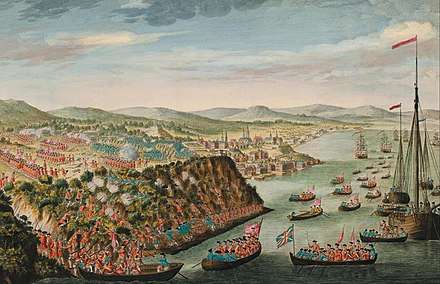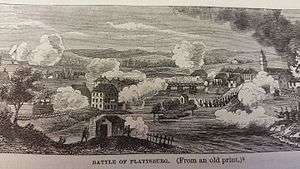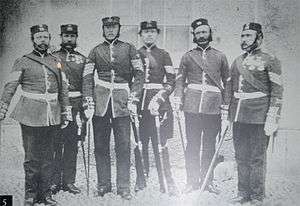58th (Rutlandshire) Regiment of Foot
The 58th (Rutlandshire) Regiment of Foot was a British Army line infantry regiment, raised in 1755. Under the Childers Reforms it amalgamated with the 48th (Northamptonshire) Regiment of Foot to form the Northamptonshire Regiment in 1881.
| 58th Regiment of Foot | |
|---|---|
| Active | 1755 to 1881 |
| Country | |
| Branch | |
| Type | Line Infantry |
| Role | Infantry |
| Size | One battalion (two battalions 1804–1815) |
| Garrison/HQ | Gibraltar Barracks, Northampton |
| Engagements | French and Indian War Anglo-Spanish War French Revolutionary Wars Napoleonic Wars New Zealand Wars Anglo-Zulu War First Boer War |
History
Early wars

The regiment was raised by Colonel Robert Anstruther[1] as the 60th Regiment of Foot in 1755 for service in the Seven Years' War.[2] It was re-ranked as the 58th Regiment of Foot, following the disbandment of the existing 50th and 51st regiments, in 1756.[2] The regiment embarked for North America in spring 1758 for service in the French and Indian War and saw action at the Siege of Louisbourg in June 1758, the Battle of the Plains of Abraham in September 1759, the Battle of Sainte-Foy and the subsequent Siege of Quebec in April to May 1760. It then took part in the final and decisive campaign between July and September 1760 when Montreal fell. The regiment then moved to the West Indies and, although eight companies of the regiment were captured by the French en route, it took part in the Battle of Havana in summer 1762 during the Anglo-Spanish War.[3] After returning to England later that year it was posted to Gibraltar in 1770 and took part in the Great Siege in the early 1780s.[3] It adopted a county designation as the 58th (Rutlandshire) Regiment of Foot in August 1782.[2]
Napoleonic Wars


The regiment embarked for the West Indies in late 1793 and fought at the capture of Martinique in February 1794 during the French Revolutionary Wars.[3] After returning to England in 1795, it was deployed, under the command of Colonel William Houston,[4] in the Capture of Minorca in November 1798.[3] The regiment then embarked for Egypt for service in the French campaign in Egypt and Syria: it saw action at the Battle of Abukir in March 1801, the Battle of Alexandria later that month and the Siege of Cairo in June 1801.[3] A second battalion was raised in 1804 to increase the strength of the regiment.[2]
The 1st battalion was deployed to Sicily in 1805 for service in the Napoleonic Wars and saw action at the Battle of Maida in July 1806.[3] It then moved to Calabria in Italy, where it participated in a raid on shipping at Diamante in September 1808.[5] It was deployed to Portugal in spring 1812 to serve under the Marquess of Wellington in the Peninsular campaign.[3] During this campaign it fought on the East Coast of the Peninsula at the Battle of Castalla in April 1813 and the Siege of Tarragona in June 1813.[3] It then embarked for North America for service in the War of 1812 and saw action at the Battle of Plattsburgh in September 1814.[3]
Meanwhile, the 2nd battalion, which was formed in 1803, saw service initially in Ireland and was then posted to Jersey in April 1804 serving there until 1809.[6] They deployed from Jersey to Portugal arriving in Lisbon[7] on 2 July 1809. The regiment initially deployed as garrison troops for Lisbon. The battalion's headquarters were based at Vila Nova on the northern edge of Lisbon; it fielded some nine companies. One company was commanded by Captain Adam Ferguson.[8] During the autumn of 1810 the newly formed "Fighting 3rd Division" led by General Thomas Picton, had the 2nd Battalion of the 58th Foot placed under its command and ordered it to move to a defensive position at the Lines of Torres Vedras.[8] The battalion then advanced with the 3rd Division and in April 1812 saw action at the Battle of Salamanca in July 1812, the Siege of Burgos in September 1812 and the Battle of Vitoria in June 1813.[3] It then pursued the French Army into France and saw action at the Battle of the Pyrenees in July 1813, the Battle of Nivelle in November 1813 and the Battle of the Nive in December 1813 as well as the Battle of Orthez in February 1814.[3] The 2nd battalion were ordered to be reduced in establishment or disbanded on 24 December 1815.[9]
The Victorian era

The regiment was deployed to Jamaica in 1816 and to Ceylon in 1828 and to New South Wales, where it took over garrison duties from the 80th Regiment of Foot, in 1843.[10] It was deployed to New Zealand for service in the New Zealand Wars in March 1845.[3] In December 1846, during the Whanganui campaign, 180 soldiers from the regiment and four Royal Artillery men were landed at Whanganui with two 12-pounder guns and began fortifying the town, building the Rutland Stockade on a hill at the town's northern end and the York Stockade towards the south. The establishment of the garrison heightened Te Mamaku's expectations of government intervention, and he vowed he would protect settlers but fight the soldiers.[11] On 16 April 1847, after a minor chief of the Wanganui people was accidentally shot by a junior army officer, about 500 or 600 heavily armed Māori formed a taua (war party) that swept down the Whanganui River, plundering and burning settlers' houses and killing and mutilating a soldier from the 58th Regiment who ventured out of the town.[11]
When a fire broke out in Auckland, New Zealand, in 1858, eventually destroying an entire city block, the men of the 58th Regiment were instrumental in firefighting efforts under the command of Colonel Robert Wynyard.[12]
Although some men from the regiment chose to settle in New Zealand,[13] the regiment returned home in 1859.[3]
The regiment was deployed to India in 1864 and remained there until 1874 when it returned to England.[3] It was sent to South Africa in 1879 for service in the Anglo-Zulu War and saw action at the Battle of Ulundi in July 1879.[3] It also fought at the Battle of Laing's Nek in January 1881 and the Battle of Majuba Hill in February 1881 during the First Boer War.[3] At the Battle of Laing's Nek it was the last regiment to carry its regimental colours into battle[13] and Lieutenant Alan Richard Hill won the Victoria Cross.[14]
As part of the Cardwell Reforms of the 1870s, where single-battalion regiments were linked together to share one depot and recruiting district in the United Kingdom, the 58th was linked with the 48th (Northamptonshire) Regiment of Foot, and assigned to district no. 29 at Gibraltar Barracks in Northampton.[15] On 1 July 1881 the Childers Reforms came into effect and the regiment amalgamated with the 48th (Northamptonshire) Regiment of Foot to form the Northamptonshire Regiment.[2]
Battle honours
Battle honours won by the regiment were:[2]
Colonels of the Regiment
Colonels of the Regiment were:[2]
60th Regiment of Foot
- 1755–1767: Lt-Gen. Robert Anstruther
58th Regiment of Foot - (1756)
- 1767–1775: Gen. The Rt. Hon. Robert Cuninghame, 1st Baron Rossmore, PC
- 1775–1776: Col. Hon. George West
- 1776–1787: Lt-Gen. Lancelot Baugh
58th (Rutlandshire) Regiment of Foot - (1782)
- 1787–1811: Gen. George Scott
- 1811–1823: Gen. Richard Lambart, 7th Earl of Cavan, KC
- 1823–1826: Gen. Thomas Graham, 1st Baron Lynedoch, GCB, GCMG
- 1826–1828: Maj-Gen. Lord Frederick Bentinck, CB
- 1828–1833: Lt-Gen. Sir Kenneth Douglas, 1st Baronet
- 1833–1848: Gen. Frederick Maitland
- 1848–1851: Lt-Gen. Sir George Charles D'Aguilar, KCB
- 1851–1864: Gen. Edward Buckley Wynyard, CB
- 1864–1868: Lt-Gen. Charles Craufurd Hay
- 1868–1870: Maj-Gen. William Sullivan, CB
- 1870–1881: Gen. Sir Arthur Johnstone Lawrence, KCB
References
- Late Lieutenant-Colonel of the 26th Regiment of Foot, Beatson, p. 426
- "58th (Rutlandshire) Regiment of Foot". regiments.org. Archived from the original on 29 December 2006. Retrieved 17 July 2016.CS1 maint: BOT: original-url status unknown (link)
- "58th (Rutlandshire) Regiment of Foot: locations". regiments.org. Archived from the original on 18 April 2007. Retrieved 15 January 2017.CS1 maint: BOT: original-url status unknown (link)
- Chichester, H. M. "Houston, Sir William, first baronet (1766–1842)". Oxford Dictionary of National Biography. Retrieved 9 January 2013.
- "No. 16208". The London Gazette. 10 December 1808. p. 1677.
- O/379/6 Regimental annual dispositions. National Archives. Retrieved 8 August 2018
- National Archive Muster and Pay Rolls 2/58th retrieved 4 August 2018
- "2nd Battalion Pay and Muster rolls". National Archives. 1809. Retrieved 4 August 2018.
- The Army List January 1817. p. 88.
- Stanley 1986, p. 81.
- Belich, p.73–74
- "Destructive fire in Auckland". Taranaki Herald - archived by PapersPast. 24 July 1858. Retrieved 27 September 2018.
- "58th (Rutlandshire) Regiment of Foot". National Army Museum. Archived from the original on 24 August 2016. Retrieved 15 January 2017.
- "No. 25084". The London Gazette. 14 March 1882. p. 1130.
- "Training Depots". Regiments.org. Archived from the original on 10 February 2006. Retrieved 16 October 2016.CS1 maint: BOT: original-url status unknown (link)
Sources
- Beatson, Robert (1806). A political index to the histories of Great Britain & Ireland. Lonman, Hurst, Rees & Orme. p. 246.
Robert Anstruther 58th 26th Regiment of Foot.
- Belich, James (1986). The New Zealand Wars. Auckland: Penguin. ISBN 0-14-027504-5.
- Stanley, Peter (1986). The Remote Garrison: The British Army in Australia. Kenthurst, New South Wales: Kangaroo Press. ISBN 0-86417-091-2.CS1 maint: ref=harv (link)
Further reading
- Wallace, Robert (1893). Regimental records of the 58th (Rutlandshire) Regiment, now the 2nd Battalion Northamptonshire Regiment. Northampton.
- Wickes, Henry (1974). Regiments of Foot. Reading, Berkshire: Osprey. ISBN 0-85045-220-1.
- A short history of the 58th Regiment, 1755; The Rutlandshire Regiment, 1782; 2nd Battalion The Northamptonshire Regiment, 1881. Lahore. 1922.